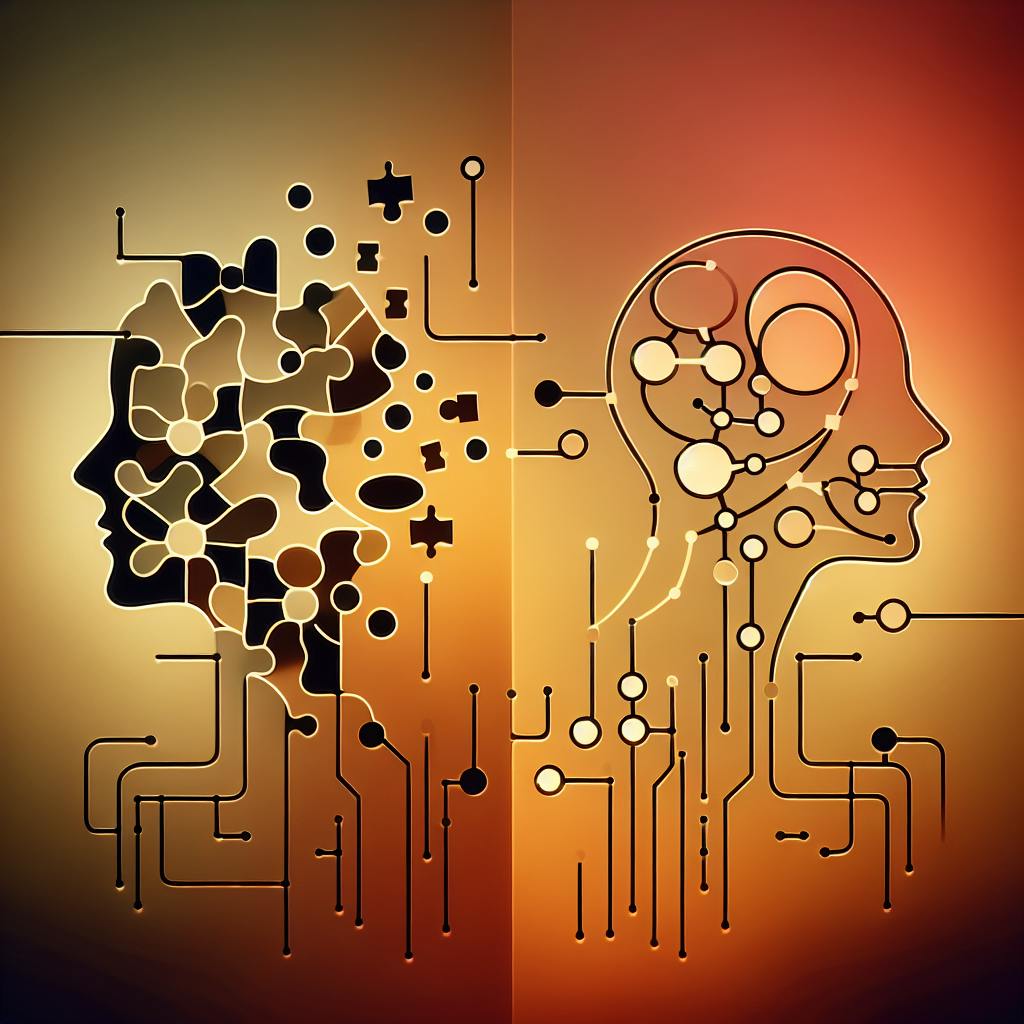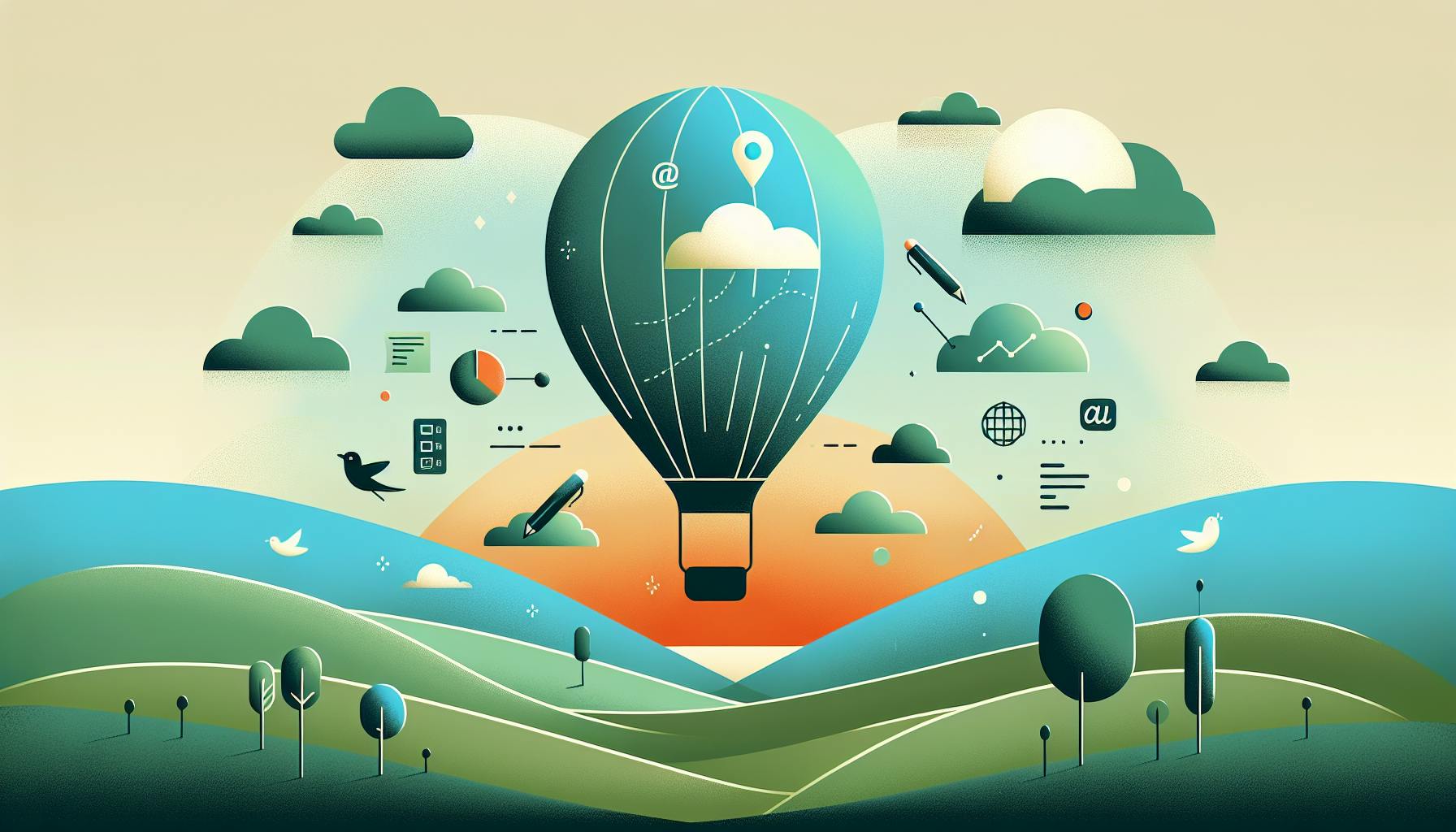Most people would agree that customizing ChatGPT can be challenging.
Luckily, AI tools provide an easy way to tailor your ChatGPT experience for enhanced conversational capabilities.
In this post, we'll explore how AI can be used to personalize ChatGPT with tailored GPTs. You'll learn the types of AI available, blueprint for building customized GPTs, and considerations for ensuring quality interactions.
Introduction to AI-Driven ChatGPT Customization
Artificial intelligence (AI) offers exciting opportunities to enhance and customize ChatGPT's capabilities. By integrating specialized AI models like natural language processing and reinforcement learning, ChatGPT can be tailored to specific needs and use cases.
This allows for more personalized and improved conversations, as the AI algorithms help ChatGPT better understand user requests and questions. The custom models also enable ChatGPT to provide more relevant and high-quality responses.
ChatGPT and the Types of AI Under the Hood
At its core, ChatGPT relies on transformer-based language models to generate human-like text. These foundation models are pretrained on vast datasets to understand linguistic patterns.
ChatGPT then uses reinforcement learning to encourage helpful, harmless, and honest responses. This fine-tunes the core AI to align with human values during conversations.
By layering additional natural language processing (NLP) models, ChatGPT can be further customized for specialized tasks. These AI algorithms help interpret user input, extract key details, and formulate intelligent replies.
Advantages of AI-Powered Customization for ChatGPT
Tailoring ChatGPT with supplemental AI delivers many benefits:
- More personalized and contextually-relevant conversations
- Enhanced understanding of niche topics and industry-specific terminology
- Improved accuracy and quality of responses
- Ability to complete specialized tasks like data analysis and content generation
The custom models essentially act as plugins to expand ChatGPT's knowledge and competencies.
Exploring the Types of AI Available for ChatGPT Customization
There are several types of AI algorithms that can customize ChatGPT:
- Domain-specific language models focus on particular areas of knowledge, like healthcare, law or computer science. This allows for expert-level conversations.
- Retrieval-augmented models connect conversations to external knowledge sources, enhancing ChatGPT's factual accuracy.
- Data analysis models enable complex quantitative reasoning and statistical evaluations.
- Task-oriented models automate workflows by understanding requests and completing procedural tasks.
As AI capabilities grow, so too will the opportunities to create tailored GPTs for ChatGPT.
Blueprint for Building Tailored GPTs with AI
Here is a high-level overview for developing custom GPTs:
- Determine the use case and required capabilities
- Gather relevant data and content to train the models
- Select appropriate AI architectures like transformers or ANNs
- Preprocess and label the training data
- Train and fine-tune models for the specialized task
- Optimize model performance through testing and iteration
- Integrate completed model with ChatGPT via API
This process allows anyone to create GPTs aligned with their needs.
Case Studies: Customized ChatGPT in Action
Many businesses are already customizing ChatGPT:
- Healthcare startups have tailored GPTs to provide accurate medical advice.
- Ecommerce sites use customized models to deliver personalized recommendations.
- Finance firms have developed intelligent assistants for investment research.
As more tailored AI comes online, ChatGPT customization will empower users and organizations.
When would you use AI?
AI can be used in a wide variety of everyday applications to enhance and customize the user experience. For example, ChatGPT itself leverages AI to have natural conversations and provide helpful information to users.
By integrating specialized AI models known as Generative Pre-trained Transformers (GPTs) into ChatGPT, users can customize and specialize its capabilities. Directory services like All GPTs make discovering and implementing these custom GPTs simple and convenient.
Some common examples of how AI GPTs are used within ChatGPT include:
-
Industry-specific expertise - There are GPTs tailored for finance, marketing, technology, and more that allow ChatGPT to provide industry-insider information.
-
Personalized interests - Custom GPTs can be created around hobbies like gaming, sports, or entertainment for enthusiasts.
-
Business applications - GPTs for customer service, sales, writing, and other business uses bring AI automation to organizations.
-
Educational support - Students can get subject-specific GPTs to help explain concepts, solve problems, and enhance learning.
So in summary, ai can be used for customizing and specializing ChatGPT's conversational AI capabilities to match users' unique needs and interests via easy-to-implement custom GPT models.
What are 4 types of AI?
AI can be categorized into four main types that demonstrate increasing capability and complexity:
-
Reactive machines: These AIs have no memory and respond to inputs with pre-defined outputs. They are designed to perform narrow, specialized tasks like playing chess.
-
Limited memory: More advanced than reactive AIs, these systems can store information to contextually respond to varied inputs within their domain. Self-driving cars use limited memory AI to navigate roads.
-
Theory of mind: This AI attempts to understand users' perspectives to have more natural conversations. Chatbots like Alexa use theory of mind to engage with human users.
-
Self-aware: Considered the most human-like AI, self-aware systems form representations about themselves. While no self-aware AI exists yet, it represents an aspirational goal for the field.
As AI capabilities grow more sophisticated, new opportunities emerge to customize ChatGPT with specialized GPTs tailored to industry needs or personal interests. Understanding different AI types helps identify the right AI for particular tasks. Whether seeking a virtual assistant, content generator, or conversational bot, the All GPTs Directory offers a expanding catalog to explore.
What is AI tools used for?
An AI tool is a software application that leverages artificial intelligence to automate tasks, analyze data, and provide insights. AI tools are being used across industries to enhance productivity and decision making.
Some common uses of AI tools include:
-
Chatbots and virtual assistants: AI powers conversational agents like Alexa, Siri and ChatGPT that can understand natural language requests and provide relevant information or complete simple tasks. These tools are used for customer service, information lookups and more.
-
Data analysis: AI techniques like machine learning can detect patterns in large datasets and build models to make predictions. This allows businesses to forecast sales, detect fraud, personalize recommendations and more based on data.
-
Computer vision: AI can analyze visual data like images and video for facial recognition, defect detection in manufacturing, analyzing medical scans and much more. This automation saves time and improves accuracy.
-
Natural language processing: NLP tools can understand text data to automate translation, interpret sentiment, extract key topics and more. This is used for chatbots, search engines, text analytics and beyond.
As AI continues advancing, more tools leveraging these technologies will emerge across industries. With custom AI models like GPTs (Generative Pre-trained Transformers), developers can build specialized assistants tailored to specific use cases. Overall, AI promises to augment human capabilities and enhances business operations through intelligent automation.
sbb-itb-b2c5cf4
What can AI be used for in business?
AI can provide a wide range of capabilities to enhance business operations and customer experiences.
Automating tasks
AI can automate routine tasks like data entry, customer service inquiries, accounting processes, and more. This helps improve efficiency and free up staff time for higher priority work. Virtual assistants powered by AI technology can interact with customers, handle simple requests, or route inquiries to the appropriate team.
Personalizing experiences
Leveraging AI and machine learning algorithms helps businesses understand customer behavior, preferences, and expectations. Brands can use these insights to deliver customized product recommendations, tailored promotions and offers, and highly relevant content for each visitor. This leads to better customer experiences.
By integrating AI for intelligent personalization, businesses see higher customer satisfaction, increased sales conversions, improved loyalty and retention over time. For example, chatbots can be designed with natural language processing to deliver helpful, personalized conversations.
Uncovering insights
Processing and analyzing large volumes of data is challenging for human teams alone. AI excels at detecting complex patterns and relationships within data to extract meaningful insights. These could reveal customer sentiment changes about products, signal shifting market forces and trends, or identify growth opportunities.
Business leaders can leverage such AI-generated intelligence to craft data-driven strategies, take calculated risks, and make smart decisions at scale. This is key to outmaneuvering the competition.
Considerations for AI-Enhanced ChatGPT Personalization
As ChatGPT becomes increasingly popular, many users are looking to further customize and enhance their experience through ai can be used for integrating additional AI models. When doing so, there are several key factors to consider.
Setting Objectives for Your AI-Enhanced ChatGPT
Before integrating any new AI technologies, it is important to clearly define your objectives. What specific abilities or functionalities are you hoping to add to ChatGPT? Some examples include:
- Enhanced capabilities for certain tasks or industries
- More personalized and context-aware responses
- Access to specialized knowledge bases or datasets
- Faster response times for complex queries
Understanding your goals will help guide you in determining the right types of AI to incorporate.
Compatibility Check: AI Models and ChatGPT
Not all AI models are created equal when it comes to integration with ChatGPT. It is crucial to assess compatibility on both a technical and functional level.
On the technical side, you need to ensure the AI framework, programming languages, and hosting platforms are compatible. Functionally, the AI outputs must align reasonably well with ChatGPT in terms of response structure, tone, safety, etc.
Testing different AI tools on a small scale first is advisable before full integration. Failing to check compatibility can lead to a disjointed and frustrating user experience.
Ensuring Quality: Accuracy, Relevance, and Safety in AI Customization
While adding AI augmentations aims to enhance ChatGPT, it should not come at the cost of reduced accuracy, relevance, or safety. Rigorously evaluating any supplemental AI on these factors helps avoid detrimental impacts.
For accuracy - does the AI have sufficient access to updated, factual information for its specialized domain?
Relevance depends on context-awareness and precise responses tailored to the query and conversation flow.
Safety equates to reliably mitigating risks like potential biases and harmful content generation.
Enforcing quality standards ensures your AI integration improves rather than impedes your customized ChatGPT solution.
Accessibility and Practicality of AI Tools for ChatGPT Enhancement
Depending on your constraints around budget, personnel, timeline, and technical expertise, some AI integration options may be more feasible than others. Open-source solutions allow DIY integration with the right skills, while pre-built modules offer convenience at a cost.
It's also key to consider scalability should user demand grow for your ChatGPT product. Assessing these practical factors helps match integrations to your unique capabilities and situation.
Testing and Monitoring: Ensuring Peak Performance in AI-Customized ChatGPT
The work does not stop after integrating additional AI into ChatGPT. Rigorously testing performance under diverse conversational scenarios and monitoring ongoing outputs is crucial.
Are responses still fast, coherent and useful? Does the AI remain consistent to its intended function over time? Testing and monitoring allows catching and fixing problems early to prevent a subpar user experience.
Consider leveraging analytics to benchmark performance over thousands of queries. This level of oversight is key to optimizing an AI-enhanced ChatGPT that maintains peak standards at scale.
When augmenting such a powerful platform like ChatGPT with AI, taking these considerations into account paves the way for responsible innovation that avoids the pitfalls. By focusing on user needs, technical compatibility, quality assurance and continuous oversight, you can achieve enhanced personalization that truly unlocks ChatGPT's full potential.
Implementing AI Tools for ChatGPT Personalization
ChatGPT has transformed how we interact with AI, providing a remarkably human-like conversational experience. However, in its default form, it has limitations in adequately meeting specialized user needs. This is where AI tools for personalization come in handy.
Refining Performance with AI Model Tuning Techniques
Fine-tuning techniques like transfer learning and prompt engineering can enhance ChatGPT's capabilities for specific domains. Transfer learning involves initializing a model with the weights of a pretrained network, retraining it on a new dataset. This enables knowledge transfer across tasks.
Prompt engineering optimizes the textual prompts provided to ChatGPT. Thoughtfully-designed prompts can guide the model to generate more accurate, relevant responses. Tools like Anthropic's Constitutional AI use prompt engineering to constrain model behavior.
Curating Data for AI: The Key to Tailored ChatGPT Experiences
Curating diverse, representative datasets is crucial for an AI assistant tailored to user needs. Data curation pipelines clean, label, and structure training data, while techniques like data augmentation artificially expand datasets.
Carefully curated data translates to more robust performance on niche tasks. For instance, a medical ChatGPT could be trained on expert-annotated transcripts of doctor-patient conversations.
Integrating Multiple AI Types Using Composition Frameworks
Hybrid AI architectures combine strengths of different techniques into a versatile assistant. This includes fusing classical AI with neural networks or blending multiple neural models.
For example, an AI writing assistant could integrate a grammar checking module with a text generation engine. Composition frameworks like TensorFlow Extended and PyTorch provide the infrastructure for seamlessly blending AI components.
Prompt Engineering: AI-Powered Techniques for Enhanced Interaction
Thoughtfully engineered prompts are key to guiding productive conversations with ChatGPT. Tools like Anthropic's Constitutional AI and Cohere's Prism use prompt engineering to constrain, correct and improve model responses.
Prompts can be designed to override previous model assumptions, adjust tone/style of replies, or provide guardrails against harmful responses. This results in more controllable, trustworthy interactions.
Maintaining Standards with AI Moderation Tools
As AI assistants handle sensitive topics, moderation tools are important to maintain quality standards. Techniques like toxicity classifiers, content flagging and human-in-the-loop review can detect harmful model responses.
Moderation enables accountable AI - notifications alert developers of issues, while mitigation measures like answer blocking prevent problematic content from reaching end-users. This upholds integrity in AI systems.
Embracing AI for Tailored Conversational Experiences with ChatGPT
AI and machine learning models like ChatGPT have opened up new possibilities for customized and personalized conversational experiences. As AI capabilities advance, we can leverage these technologies to enhance interactions and tailor solutions to individual needs.
Some key ways AI is shaping the future of conversational systems:
-
Creating niche-specific chatbots: With the right training data and objectives, AI can produce specialized chatbots for different industries and use cases. Rather than a one-size-fits-all assistant, AI allows custom GPTs optimized for certain tasks or audiences.
-
Personalization at scale: AI can analyze user data and behavior to understand preferences. It can then adjust conversations and recommendations accordingly. This level of personalization is difficult to achieve manually across large user bases.
-
Natural language processing: Cutting edge NLP techniques enable more natural and contextual conversations. As AI language models continue to advance, interactions will become more fluid and human-like.
-
Continuous improvement: With user feedback and more training data, AI models can keep getting better. Conversational systems can evolve and improve over time rather than remain static.
As this technology continues maturing, integrating AI thoughtfully presents an opportunity to enrich user experiences. The customizability and personalization unlocked by AI can lead to more satisfying and productive conversations for all.


